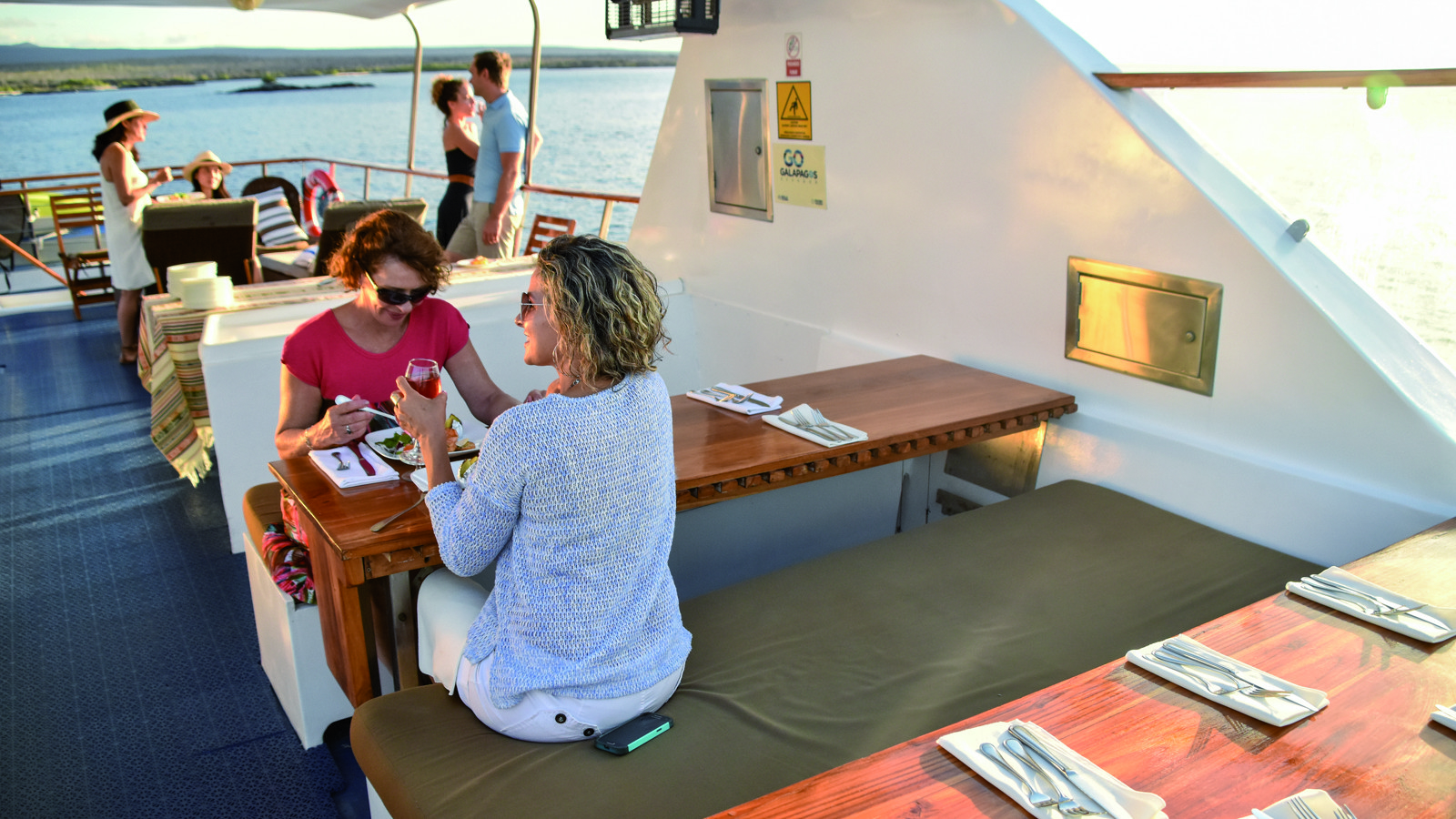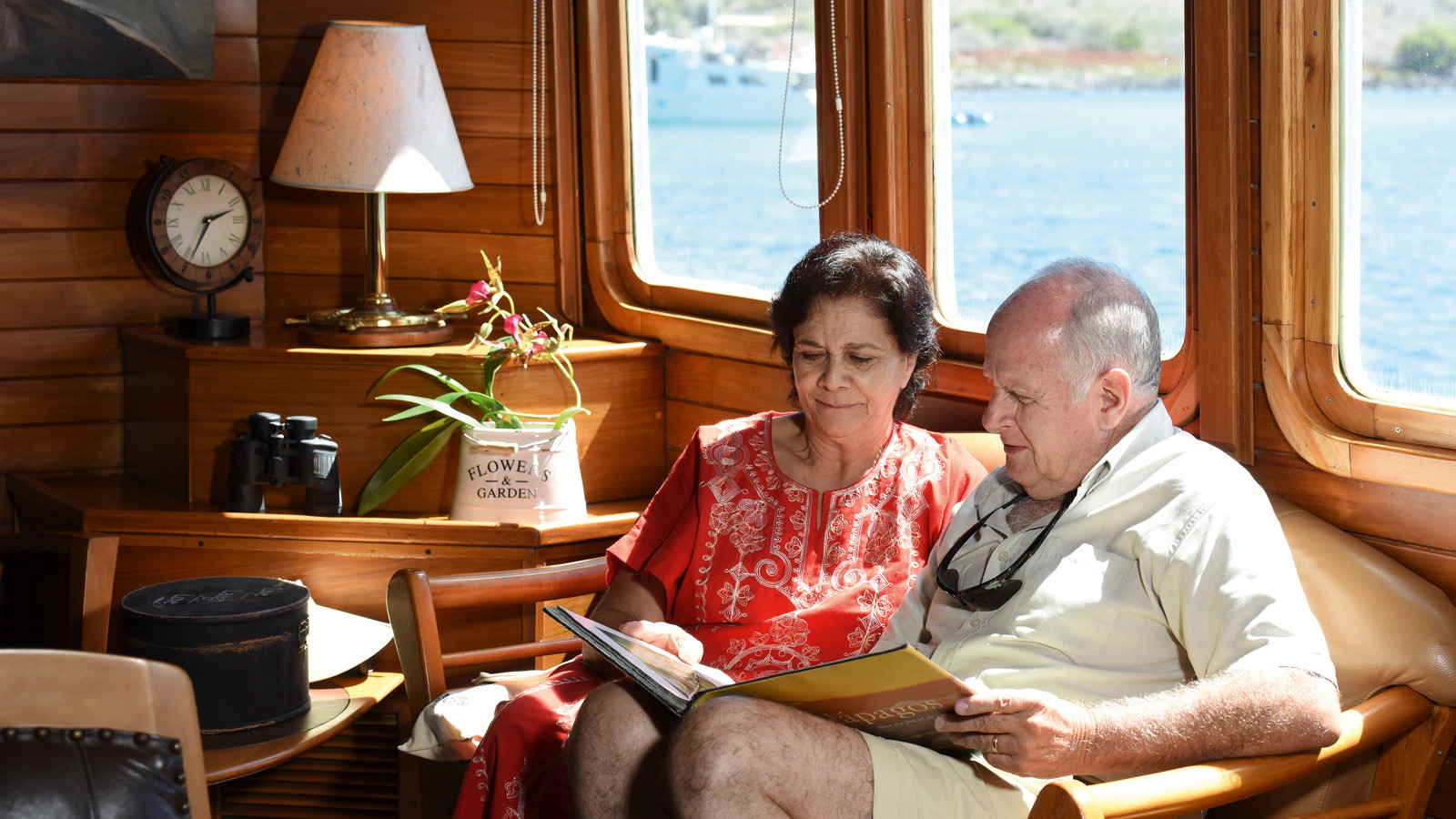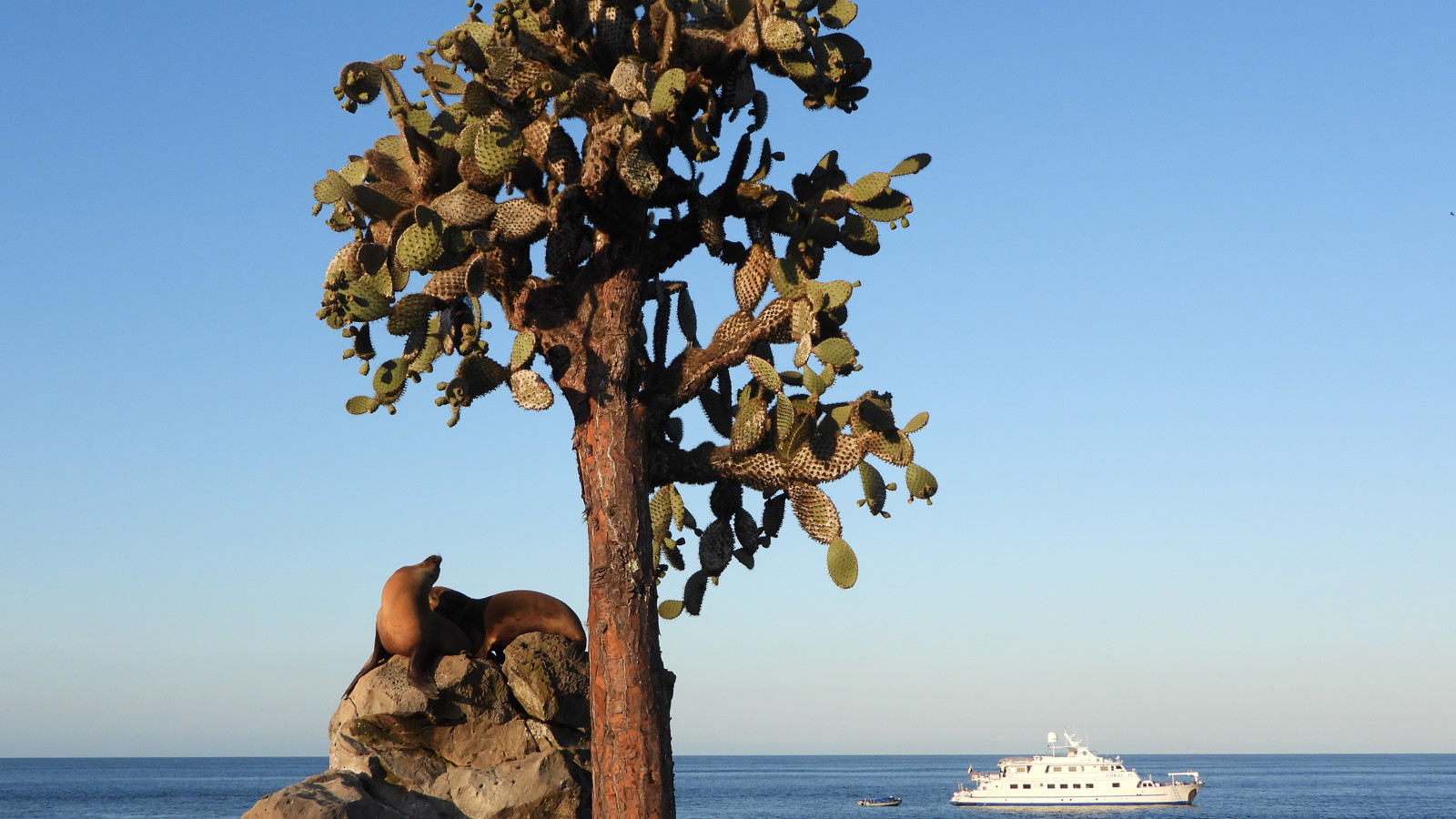The Galapagos Islands are located on the Equator, in the Pacific Ocean, nearly 600 miles off mainland Ecuador. Here we can swim with sea lions and photograph iguanas and giant tortoises. The animals are unafraid of humans and for anyone interested in wildlife, the Galapagos archipelago is a true oasis. Since 2003, we have taken adventurous travellers to this wildlife haven - now it's your turn!
-
Maximum 19 participants
-
7 nights in the Galapagos
-
Visit 8 different islands
-
Encounter giant tortoises, iguanas & sea lions
-
5 nights on mainland Ecuador
-
Visit the National Parks Antisana & Cajas
Facts about the trip
Itinerary
This exciting trip starts on mainland Ecuador, where we explore the Antisana National Park and the capital, Quito. We continue to the Galapagos Islands and spend seven nights on board the comfortable 19-passenger yacht Coral II. A PolarQuest guide will escort us throughout the trip and in Galapagos two knowledgeable National Park guides will join us. We will use sturdy rubber boats (pangas) to make daily landfalls and explore the islands’ unique flora and fauna. There is snorkelling equipment on board and we will get several chances to explore the amazing underwater world of these enchanted islands. We photograph tortoises and meet charming and playful sea lions on white sandy beaches. The animals of the Galapagos are curious and unafraid of humans and we will have many incredible and close wildlife encounters. After eight days in the Galapagos we return to mainland Ecuador and head to the Andean highlands. We stay in Cuenca, known for its beauty and impressive colonial architecture. We also explore the magnificent Cajas National Park.
Day 1: Quito
You arrive with own flight to Quito’s International Airport, situated at 9300 ft above sea level and flanked by the snow-capped peaks of the Andes. We check in to the charming Café Cultura Manor and have our first dinner together, the first of many more to come. We spend the night at Café Cultura Manor.
Day 2: Quito
We explore the old town of Quito, listed as an UNESCO's World Heritage site. We also visit El Panecillo, from where we have an excellent view of Quito. Afterwards we go back to Café Cultura Manor to spend the night.
Day 3: Antisana National Park
We spend a full day in the Antisana National Park. Here we have great chances to see eagles, Caracas and the majestic condor, which is the largest bird in the Western Hemisphere. After this we go back to Café Cultura Manor to spend the night.
Day 4: Quito - Baltra - Santa Cruz, Galapagos
We fly from Quito to Baltra in Galapagos early in the morning and board our comfortable motor yacht Coral II. We start off our journey with the island of Santa Cruz. We have a dinghy ride at the entry of the Itabaca Channel in a lagoon with turquoise water, where we can observe sharks, blue-footed boobies and different kinds of fish. In the evening we will enjoy our first dinner on board.
Day 5: Genovesa Island
At El Barranco we will be marveled at the variety of sea life that uses the crevices of the lava cliffs for shelter. Red-billed Tropicbirds fly overhead, and a small colony of fur seals may be found near the landing site. We will be dropped off at a steep stairway that begins on rocks at the foot of a path that leads through a seabird colony full of Nazca and Red footed Boobies.
From within the flooded caldera of Tower Island, we set foot onto the sandy beach of Darwin Bay to be greeted by swallow tailed gulls often said to be the most beautiful gull in the world. In the trail we can see at nesting red footed boobies and great frigatebirds.
Day 6: Rabida Island & Bartolome Island
Lying at the archipelago's heart, the dramatic Rabida Island with a distinctive red-sand beach is home to sea lions, mockingbirds, finches, endemic Galapagos doves, and vermilion flycatchers. A morning walk takes us through a forest of palo santo and cacti to a beautiful overview of the bay.
In the afternoon we will go to Bartolome Island, considered the most iconic landscape of the entire archipelago. The view from the top of Bartolome Island, overlooking the famous Pinnacle Rock and the austere Santiago Island is stunning. Our subsequent snorkel here might put us face to face with Galapagos penguins, white tipped reef sharks, and playful sea lions.
Day 7: Santa Cruz Island
This morning we visit the Charles Darwin Research Centre, where giant tortoises and land iguanas are bred. During our exciting tour we learn more about these fascinating pre-historic animals. Also in the central highlands of Santa Cruz Island, we have our best opportunity to interact at close quarters with totally wild, Galapagos giant tortoises. A short walk among these huge, 6001b, reptiles will also offer the chance for more species, especially several species of the famed finches.
After lunch we will visit the Black Turtle cove, on the north shore of Santa Cruz Island. Accessible only by sea, four species of mangrove crowd form this internal lagoon, turtles visit the calm waters, peaking their heads above the surface while fish, rays circle below. White-tipped reef sharks can be seen beneath the boat, plus sea birds, including pelicans, herons and egrets. This cove has been declared as a "turtle sanctuary".
Day 8: Isabela & Fernandina
Today we get familiar with Isabela, the largest island in the archipelago, formed by six young and still active volcanoes. As we cruise along the cliffs at Punta Vicente Roca we hope to spot the Nazca boobies, blue-footed boobies and the endemic flightless cormorant.
Later, on our way to Fernandina, we cross the Bolívar Channel and keep a look out for whales and dolphins. Fernandina is the youngest island of the Galapagos and has no introduced animal or plant species. Punta Espinoza is famous for its large colonies of marine iguanas. It is also the habitat of Sally Lightfoot crabs and sea lions as well as several unique species such as the flightless cormorant, Galapagos penguin and Galapagos hawk - the king of the predators on the islands. The landscape is dominated by cactuses, mangrove areas and different types of lava flows.
Day 9: Isabela
We return to Isabela and go ashore at the black volcanic beach of Urbina Bay. During a walk we hope to encounter the colourful land iguanas. This is also one of Galapagos’ many great snorkelling sites and we have the chance to swim with sea turtles, sea lions and countless tropical fish.
Close to Urbina Bay is Targus Cove, a natural harbour, where whalers and pirates from centuries ago painted and carved their ships’ names on the rocks. From here we make our way up to Darwin’s crater, which today is a salt-water lake, to enjoy the rewarding views of lava fields and volcanic formations. Afterwards, we enjoy a panga (rubber boat) ride along the shoreline to admire a variety of seabirds such as blue-footed boobies and flightless cormorants. If we are lucky, we may also encounter the little Galapagos penguin – the only penguin species in the world living in the tropics.
Day 10: Santiago Island
Egas Port is a black volcanic sand beach, visited by Darwin in 1835. The unique, truly striking layered terrain of Santiago shore is home to a variety of animals including the bizarre yellow-crowned night heron and marine wildlife including lobster, starfish and marine iguanas grazing on algae beds alongside Sally Lightfoot crabs. It is also common to see colonies of endemic fur seals swimming in cool water volcanic rock pools.
On the South-eastern side of Santiago Island we find Sullivan Bay, named after Bartholomew James Sullivan - a lieutenant on Darwin’s vessel, the Beagle. Here we take a walk through a fascinating moon landscape, where the young pa-hoe-hoe lava flows were formed during the last quarter of the 19th century.
Day 11: Santa Cruz - Guayaquil
Named for some wrecked World War II barges whose ribs are still visible in the sand this visitor site at Bachas Beach offers great swimming, a lovely walk along the shore, and a visit to a lagoon behind the high tide line with wading birds, marine iguanas and sometimes even flamingoes. The two beaches are also favorite nesting sites for green turtles which often leave tractor-like tracks in the sand.
It is now time to say goodbye to this enchanting group of islands and fly to Guayaquil in Ecuador to explore the highlands. On our way towards the mountains we travel through a changing landscape. After a few hours’ bus drive, we reach Cuenca and check in at Mansion Alcázar, an impressive piece of architecture from colonial times.
Day 12: Cuenca
Today, we explore the city Cuenca and visit the local market. Here we find Indian jewelry, textiles and exotic fruits. In the evening we enjoy our last dinner at our hotel Mansion Alcázar.
Day 13: Cajas National Park - Guayaquil
Travelling through high Andean mountain passes we reach Cajas National Park. Here we walk among the impressive paper bark trees, while our guide helps us identify some of the area’s many colourful bird species. In the afternoon we return to Guayaquil, leave Ecuador to fly back home.
Day 14: Arrive home
Back home.
Please note: Our exact route and port calls will depend on local authorities and might be subject to change.
Map
Map - Itinerary in Galapagos

Videos from this trip
Coral II
Passengers
19Crew
11Built
2004Cruising Speed
12 knOur expedition yacht was refurbished in 2018 and the comfortable cabins accommodate 19 passengers. The yacht has the latest navigation equipment and is decorated in classic maritime style with teak and brass.
All cabins are air-conditioned, have private shower/WC and windows/port holes. Facilities on board include a comfortable lounge, a dining room, a well-stocked bar, three sun decks and a plunge pool. The bridge is open to visitors at all times.
Departures and booking
| Departure | Return trip | Cabins available | |
|---|---|---|---|
| 2 October 2025 | 15 October 2025 | Fully booked | More info |
Lodging & prices
| Lodging category | Bed | Prices 2025/person | |
|---|---|---|---|
| Standard Cabin | 2 separate beds or double bed | 10 990 USD | |
| Superior cabin | 2 separate beds or double bed | 11 990 USD | |
| Standard Cabin for single use | 14 290 USD | ||

Included in the price:
- Flights Quito - Galapagos, Galapagos - Guayaquil
- 7 nights on board the Coral II
- 3 night at Cultura Manor in Quito
- 2 nights at Mansion Alcázar in Cuenca
- All transfers
- All meals
- 1 PolarQuest tour leader
- 2 National Park guides in Galapagos and local guides in Ecuador
- Lectures on board and guided walks ashore
- Snorkeling equipment and wetsuit on board Coral II
- Entrance Fee to the Galapagos National Park (USD 200)
- The customary gratuity to all local guides and ship’s crew
Not included in the price:
- International flights to and from Ecuador
- Travel and cancellation insurance
- Beverages
- Airport taxes











































